HYUNDAI Entourage User Manual
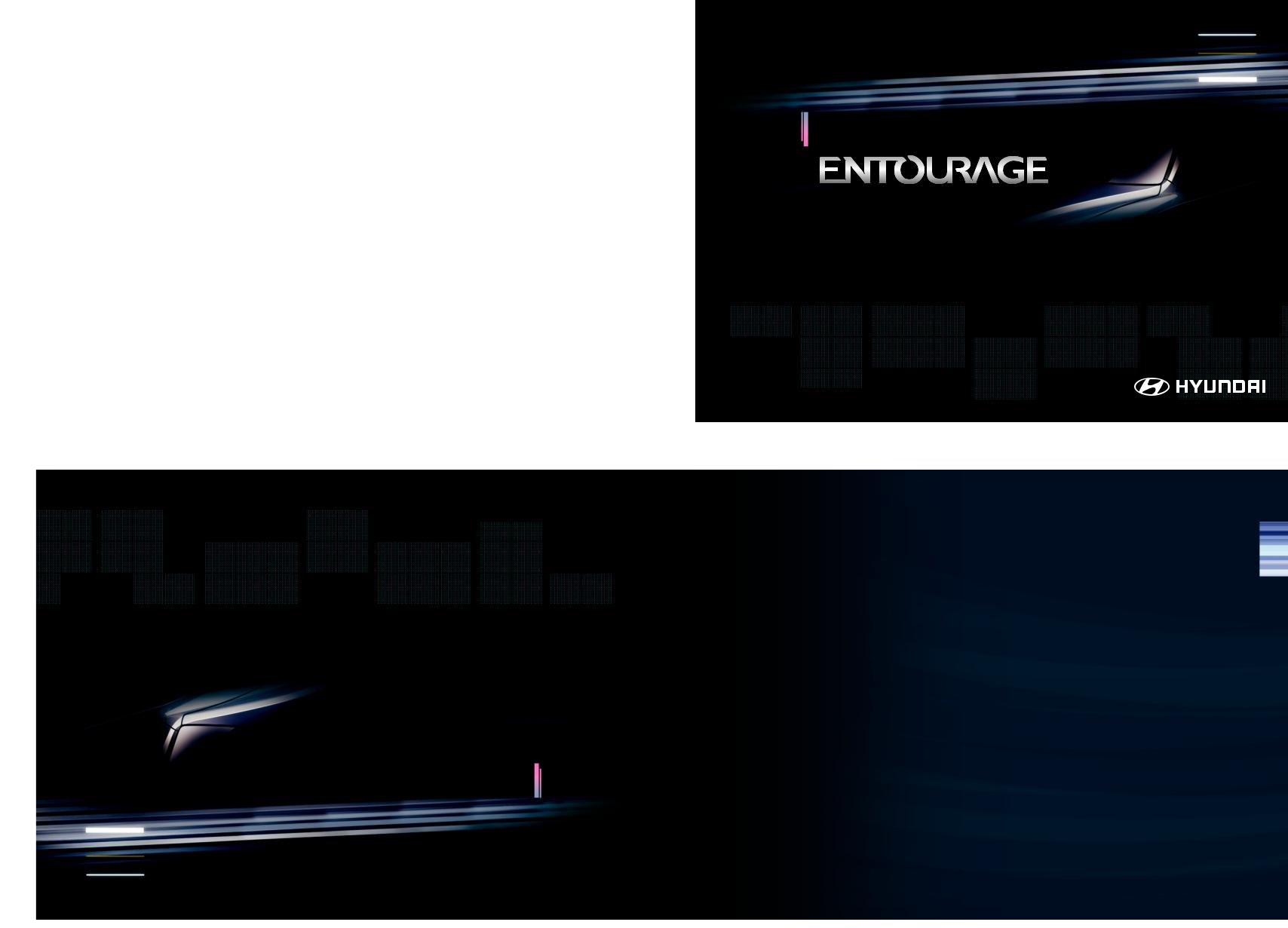
2009 Owner’s Manual

WARRANTIES FOR YOUR HYUNDAI VEHICLE
Please consult your Owner's Handbook & Warranty Information booklet for your vehicle's specific warranty coverage.
RESPONSIBILITY FOR MAINTENANCE
The maintenance requirements for your new Hyundai are found in Section 7. As the owner, it is your responsibility to see that all maintenance operations specified by the manufacturer are carried out at the appropriate intervals. When the vehicle is used in severe driving conditions, more frequent maintenance is required for some operations. Maintenance requirements for severe operating conditions are also included in Section 7.

OWNER'S MANUAL
Operation
Maintenance
Specifications
All information in this Owner's Manual is current at the time of publication. However, Hyundai reserves the right to make changes at any time so that our policy of continual product improvement may be carried out.
This manual applies to all Hyundai models and includes descriptions and explanations of optional as well as standard equipment. As a result, you may find material in this manual that does not apply to your specific vehicle.
F1

CAUTION: MODIFICATIONS TO YOUR HYUNDAI
Your Hyundai should not be modified in any way. Such modifications may adversely affect the performance, safety or durability of your Hyundai and may, in addition, violate conditions of the limited warranties covering the vehicle. Certain modifications may also be in violation of regulations established by the U.S. Department of Transportation and other federal or state agencies.
TWO-WAY RADIO OR CELLULAR TELEPHONE INSTALLATION
Your vehicle is equipped with electronic fuel injection and other electronic components. It is possible for an improperly installed/adjusted two-way radio or cellular telephone to adversely affect electronic systems. For this reason, we recommend that you carefully follow the radio manufacturer's instructions or consult your Hyundai dealer for precautionary measures or special instructions if you choose to install one of these devices.
F2
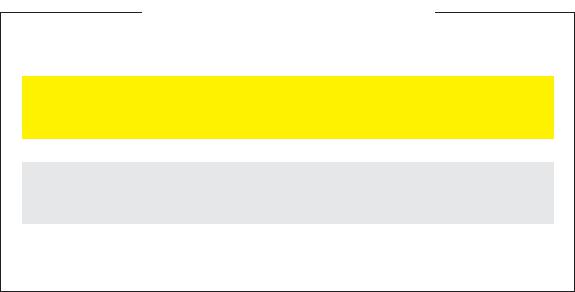
SAFETY AND VEHICLE DAMAGE WARNING
This manual includes information titled as WARNING, CAUTION and NOTICE.
These titles indicate the following:
 WARNING
WARNING
This indicates that a condition may result in harm, serious injury or death to you or other persons if the warning is not heeded. Follow the advice provided with the warning.
 CAUTION
CAUTION
This indicates that a condition may result in damage to your vehicle or its equipment if the caution is not heeded. Follow the advice provided with the caution.
NOTICE
This indicates that interesting or helpful information is being provided.
F3

FOREWORD
Thank you for choosing Hyundai. We are pleased to welcome you to the growing number of discriminating people who drive Hyundais. The advanced engineering and high-quality construction of each Hyundai we build is something of which we're very proud.
Your Owner's Manual will introduce you to the features and operation of your new Hyundai. It is suggested that you read it carefully because the information it contains can contribute greatly to the satisfaction you receive from your new car.
The manufacturer also recommends that all service and maintenance on your car be performed by an authorized Hyundai dealer. Hyundai dealers are prepared to provide high-quality service, maintenance and any other assistance that may be required.
HYUNDAI MOTOR AMERICA
Note : Because future owners will also need the information included in this manual, if you sell this Hyundai, please leave the manual in the vehicle for their use. Thank you.
 CAUTION
CAUTION
Severe engine and transaxle damage may result from the use of poor quality fuels and lubricants that do not meet Hyundai specifications.You must always use high quality fuels and lubricants that meet the specifications listed on Page 8-3 in the Vehicle Specifications section of the Owner's Manual and which also appear in the Service Station Information on the back cover of the Owner's Manual.
Copyright 2008 Hyundai Motor America. All rights reserved. No part of this publication may be reproduced, stored in any retrieval system or transmitted in any form or by any means without the prior written permission of Hyundai Motor America.
F4
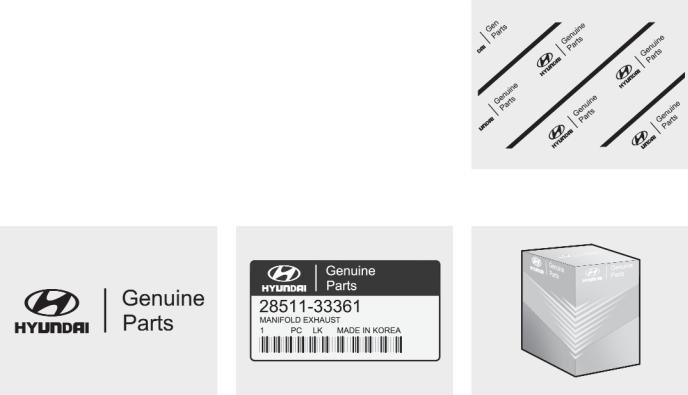
Guide to Hyundai Genuine Parts
1.What are Hyundai Genuine Parts?
Hyundai Genuine Parts are the same parts used by Hyundai Motor Company to manufacture vehicles. They are designed and tested for the optimum safety, performance, and reliability to our customers.
2.Why should you use genuine parts?
Hyundai Genuine Parts are engineered and built to meet rigid manufacturing requirements. Using imitation, counterfeit or used salvage parts is not covered under the Hyundai New Vehicle Limited Warranty or any other Hyundai warranty.
A100A01L
In addition, any damage to or failure of Hyundai Genuine Parts caused by the installation or failure of an imitation, counterfeit or used salvage part is not covered by any Hyundai Warranty.
3.How can you tell if you are purchasing Hyundai Genuine Parts?
Look for the Hyundai Genuine Parts Logo on the package (see below).
Hyundai Genuine Parts exported to the United States are packaged with labels written only in English.
Hyundai Genuine Parts are only sold through authorized Hyundai Dealerships.
A100A02L
To find the closest authorized dealer call 1-800-826-CARS
A100A03L
A100A04L
F5


|
|
|
|
|
|
|
|
|
Introduction |
|
1 |
|
|
|
|
|
|
|
|
|
Your vehicle at a glance |
|
2 |
|
|
|
|
|
|
|
|
|
Features of your vehicle |
|
3 |
|
|
|
|
|
|
|
|
|
Driving your vehicle |
|
4 |
|
|
|
|
|
|
table of contents |
|
|
What to do in an emergency |
|
5 |
|
|
||||
|
|
|
|
|
|
|
|
|
Maintenance |
|
6 |
|
|
|
|
|
|
|
|
|
Consumer information, Reporting safety defects |
|
7 |
|
|
|
|
|
|
|
|
|
Specifications |
|
8 |
|
|
|
|
|
|
|
|
|
Index |
|
9 |
|
|
|
|
|
|
|
|
|
|
|
|

Introduction |
|
1 |
|
|
|
How to use this manual / 1-2
Fuel requirements / 1-2
Vehicle break-in process / 1-3
Vehicle data collection and event data recorders / 1-4
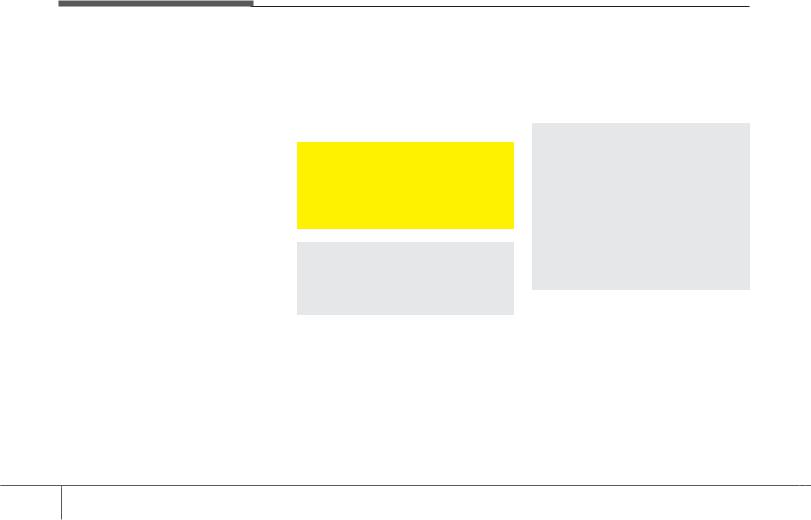
Introduction
HOW TO USE THIS MANUAL
We want to help you get the greatest possible driving pleasure from your vehicle. Your Owner’s Manual can assist you in many ways. We strongly recommend that you read the entire manual. In order to minimize the chance of death or injury, you must read the WARNING and CAUTION sections spread throughout the manual.
Illustrations complement the words in this manual to best explain how to enjoy your vehicle. By reading your manual, you learn about features, important safety information, and driving tips under various road conditions.
The general layout of the manual is provided in the Table of Contents. A good place to start is the index; it has an alphabetical listing of all information in your manual.
Sections: This manual has eight sections plus an index. Each section begins with a brief list of contents so you can tell at a glance if that section has the information you want.
You’ll find various WARNING’s, CAUTION’s, and NOTICE’s information in this manual. These were prepared to enhance your personal safety.You should carefully read and follow ALL procedures and recommendations provided in these WARNING’s, CAUTION’s and NOTICE’s.
 WARNING
WARNING
A WARNING indicates a situation in which harm, serious bodily injury or death could result if the warning is ignored.
 CAUTION
CAUTION
A CAUTION indicates a situation in which damage to your vehicle could result if the caution is ignored.
NOTICE
A NOTICE indicates interesting or helpful information is being provided.
FUEL REQUIREMENTS
Use Unleaded Gasoline
Unleaded gasoline with a Pump Octane Rating of 87 (Research Octane Number 91) or higher must be used in your Hyundai.
 CAUTION
CAUTION
•Do not "top off" after the nozzle automatically shuts off when refueling.
•Tighten the cap until it clicks, oth-
erwise the " " light will illuminate.
" light will illuminate.
•Always check that the fuel cap is installed securely to prevent fuel spillage in the event of an accident.
What About Gasohol?
Gasohol (a mixture of 90% unleaded gasoline and 10% ethanol or grain alcohol) may be used in your Hyundai. However, if your engine develops driveability problems, the use of 100% unleaded gasoline is recommended. Fuels with unspecified quantities of alcohol, or alcohols other than ethanol, should not be used.
1 2

Use of MTBE
Hyundai recommends that fuels containing MTBE (Methyl Tertiary Butyl Ether) over 15.0% vol. (Oxygen Content 2.7% weight) should not be used in your Hyundai.
Fuel containing MTBE over 15.0% vol. (Oxygen Content 2.7% weight) may reduce vehicle performance and produce vapor lock or hard starting.
Do Not Use Methanol
Fuels containing methanol (wood alcohol) should not be used in your Hyundai. This type of fuel can reduce vehicle performance and damage components of the fuel system.
 CAUTION
CAUTION
Your Hyundai's New Vehicle Limited Warranty may not cover damage to the fuel system and any performance problems that are caused by the use of fuels containing methanol or fuels containing MTBE (Methyl Tertiary Butyl Ether) over 15.0% vol. (Oxygen Content 2.7% weight.)
Gasolines for Cleaner Air
To help contribute to cleaner air, Hyundai recommends that you use gasolines treated with detergent additives, which help prevent deposit formation in the engine. These gasolines will help the engine run cleaner and enhance performance of the Emission Control System.
Operation in Foreign Countries
If you are going to drive your Hyundai in another country, be sure to:
•Observe all regulations regarding registration and insurance.
•Determine that acceptable fuel is available.
Introduction
VEHICLE BREAK-IN PROCESS
During the First 1,200 Miles (2,000 Km)
No formal "break-in" procedure is required with your new Hyundai. However, you can contribute to the economical operation and durability of your Hyundai by observing the following recommendations during the first 1,200 miles (2,000 km).
•Don't drive faster than 55 MPH (88 km/h).
•While driving, keep your engine speed (rpm, or revolutions per minute) between 2,000 rpm and 4,000 rpm.
•Use moderate acceleration. Don't start quickly or depress the accelerator pedal fully.
•For the first 200 miles (300 km), try to avoid hard stops.
•Whether going fast or slow, vary your speed from time to time.
•Don't let the engine idle longer than 3 minutes at one time.
•Don't tow a trailer during the first 1,200 miles (2,000 km) of operation.
1 3

Introduction
VEHICLE DATA COLLECTION AND EVENT DATA RECORDERS
Your Hyundai vehicle is equipped with many high technology, electronically controlled systems that help to ensure your vehicle operates properly and provides the performance that you expect. These systems utilize computers to monitor the operation of various systems and components and help to control their operation. These computerized system operations are wide-ranging and involve components to reduce emissions, to continuously evaluate the readiness of the airbag and seat belt pretensioner systems, to determine when the airbag and seat belt pre-tensioner systems should be deployed and then to activate the deployment, and if equipped, to operate anti-lock braking, traction control and electrical stability control to assist the driver to control the vehicle in difficult driving situations. These systems electronically store information that is useful to service technicians when they need to diagnose and repair these systems.
Additional information is stored only when a crash occurs that results in the deployment of the airbags or seat belt pre-tensioners. This type of data storage is done by devices called event data recorders(EDR).
After a crash event, the airbag and seat belt pre-tensioner computer system, known as the Supplemental Restraint System Control Module (SRSCM) or Airbag Control Unit (ACU), may record some information about the condition of the vehicle and how it was being operated. This information consists of data related to seat belt usage and if there was diagnostic information in the airbag or seat belt systems at the time that a crash occurred, and if the ACU sensed that a crash of sufficient severity occurred to require seat belt pre-tensioner or airbag deployment.
To retrieve this information, special equipment is needed and access to the vehicle or the device that stores the data is required. Hyundai will not access information about a crash event or share it with others except:
•in response to an official request of police or similar government office, or
•with the consent of the vehicle owner or, if the vehicle is leased, with the consent of the lessee, or
•as part of Hyundai’s defense of litigation, or
•as required by law.
1 4

Your vehicle at a glance |
|
2 |
|
|
|
Interior overview / 2-2
Instrument panel overview / 2-3
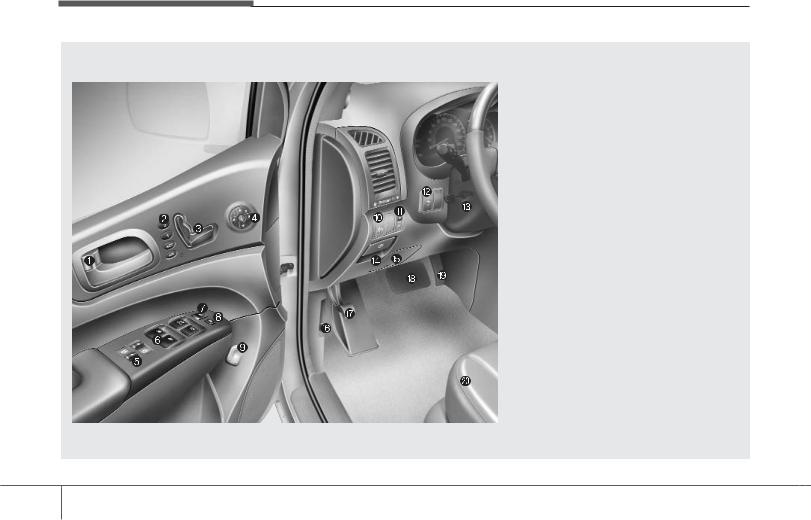
Your vehicle at a glance
INTERIOR OVERVIEW
1. |
Door lock/unlock button .................... |
3-13 |
|
2. |
Driver position memory system*....... |
3-57 |
|
3. |
Seat adjust knob*.............................. |
3-39 |
|
4. |
Outside rearview mirror control |
|
|
|
switch ............................................. |
3-105 |
|
5. Power rear quarter window |
|
||
|
switches*........................................... |
3-28 |
|
6. Power window switches .................... |
3-28 |
||
7. |
Central door lock switch.................... |
3-13 |
|
8. Power window lock switch................. |
3-28 |
||
9. |
Fuel filler lid release button............... |
3-30 |
|
10. |
Instrument panel illumination* ...... |
3-112 |
|
11. |
Room light main control switch..... |
3-125 |
|
12. Power adjustable pedal control |
|
||
|
|
switch*............................................. |
3-59 |
13. |
Steering wheel tilt ......................... |
3-103 |
|
14. |
Parking brake release lever*........... |
4-19 |
|
15. Fuse box ......................................... |
6-27 |
||
16. |
Hood release lever ......................... |
3-29 |
|
17. |
Parking brake pedal........................ |
4-19 |
|
18. Brake pedal..................................... |
4-17 |
||
19. |
Accelerator pedal.............................. |
4-6 |
|
20. Seat................................................. |
3-36 |
||
* : if equipped |
|
||
OVQ029001N
2 2
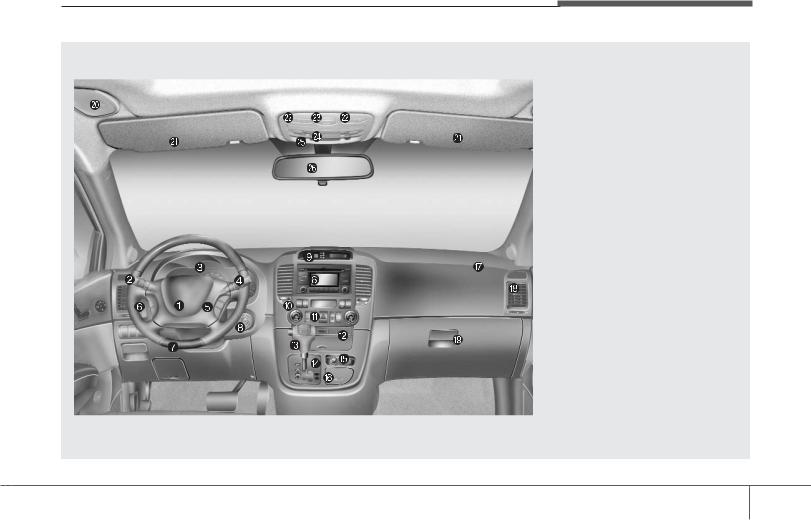
Your vehicle at a glance
INSTRUMENT PANEL OVERVIEW
1. |
Driver’s air bag ............................... |
3-79 |
|
2. |
Light control / Turn signals ........... |
3-129 |
|
3. |
Instrument cluster......................... |
3-109 |
|
4. Wiper/Washer............................... |
3-132 |
||
5. |
Auto cruise controls* ...................... |
4-14 |
|
6. |
Audio controls* ............................. |
3-181 |
|
7. |
Steering wheel ............................. |
3-102 |
|
8. |
Ignition switch................................... |
4-5 |
|
9. |
Digital clock .................................. |
3-180 |
|
10. |
Climate control system* ............. |
3-138 |
|
11. |
Hazard warning flasher switch ... |
3-137 |
|
12. Seat warmer* ............................... |
3-44 |
||
13. |
Shift lever ....................................... |
4-7 |
|
14. |
Cigar lighter* or power outlet* .... |
3-175 |
|
15. |
Power outlet................................ |
3-179 |
|
16. |
Ashtray*...................................... |
3-176 |
|
17. |
Passenger’s air bag...................... |
3-79 |
|
18. Vent controls............................... |
3-141 |
||
19. Glove box ................................... |
3-174 |
||
20. |
Sunglass holder* ........................ |
3-174 |
|
21. |
Sunvisor ..................................... |
3-178 |
|
22. Power sliding door and power |
|
||
|
|
tailgate controls*........................... |
3-17 |
23. |
Sunroof* ....................................... |
3-33 |
|
24. |
Conversation mirror.................... |
3-108 |
|
25. Trip computer* ............................ |
3-113 |
||
26. |
Day/night rearview mirror ........... |
3-107 |
|
* : if equipped |
|
||
OVQ029002N
2 3

Keys / 3-3
Remote keyless entry / 3-4
Theft-alarm system / 3-7
Immobilizer system / 3-8
Door locks / 3-10
Power sliding door and power tailgate / 3-17
|
Features of your vehicle |
|
3 |
|
|
|
|
|
|
|
|
Window / 3-26 |
|
|
|
|
Hood / 3-29 |
|
|
|
|
Fuel filler lid / 3-30 |
|
|
|
|
Sunroof / 3-33 |
|
|
|
|
Seat / 3-36 |
|
|
|
|
Driver position memory system / 3-57 |
|
|
|
|
Power adjustable pedals / 3-59 |
|
|
|
|
Seat belts / 3-59 |
|
|
|
|
Child restraint system / 3-71 |
|
|
|
|
Air bags-advanced restraint system / 3-78 |
|
|
|
|
Steering wheel / 3-102 |
|
|
|
|
Mirrors / 3-104 |
|
|
|
|
Instrument cluster / 3-109 |
|
|
|
|
Gauges / 3-110 |
|
|
|
|
Trip computer / 3-113 |
|
|
|
|
Warnings and indicators / 3-119 |
|
|
|
|
|
|
|

|
|
Interior lights / 3-125 |
|
|
|
|
Lighting / 3-128 |
|
|
|
|
Wipers and washers / 3-132 |
|
|
|
|
Horn / 3-135 |
|
|
|
|
Defroster / 3-136 |
|
|
|
|
|
|
|
|
|
|
|
|
3 |
|
Features of your vehicle |
|
|
|
|
|
|
|
|
|
Hazard warning flasher / 3-137 |
|
|
|
|
Manual climate control system / 3-138 |
|
|
|
|
Automatic climate control system / 3-150 |
|
|
|
|
Windshield defrosting and defogging / 3-164 |
|
|
|
|
Luggage net holder / 3-167 |
|
|
|
|
Roof rack / 3-168 |
|
|
|
|
Homelink® wireless control system / 3-169 |
|
|
|
|
Storage compartments / 3-173 |
|
|
|
|
Interior features / 3-175 |
|
|
|
|
Antenna / 3-180 |
|
|
|
|
Audio remote control / 3-181 |
|
|
|
|
Audio system / 3-182 |
|
|
|
Rear seat entertainment system / DVD player / 3-214 |
|
|
|
|
|
|
|
|
|
|
|
|
|

KEYS
1VQA2001
The key code number is stamped on the plate attached to the key set. Should you lose your keys, this number will enable an authorized Hyundai Dealer to duplicate the keys easily. Remove the plate and store it in a safe place. Also, record the code number and keep it in a safe and handy place, but not in the vehicle.
Key operations
Master key
Used to start the engine, lock and unlock the doors, lock and unlock the glove box and center console storage (if equipped).
 WARNING
WARNING
•NEVER leave the ignition key in the vehicle.
•NEVER leave any child unattended in the vehicle. Even very young children may inadvertently cause the vehicle to move, entangle themselves in the windows, or otherwise injure themselves or others.
Features of your vehicle
 WARNING
WARNING
Use only Hyundai original parts for the ignition key in your vehicle. If an aftermarket key is used, the ignition switch may not return to ON after START. If this happens, the starter will continue to operate causing damage to the starter motor and possible fire due to excessive current in the wiring.
3 3
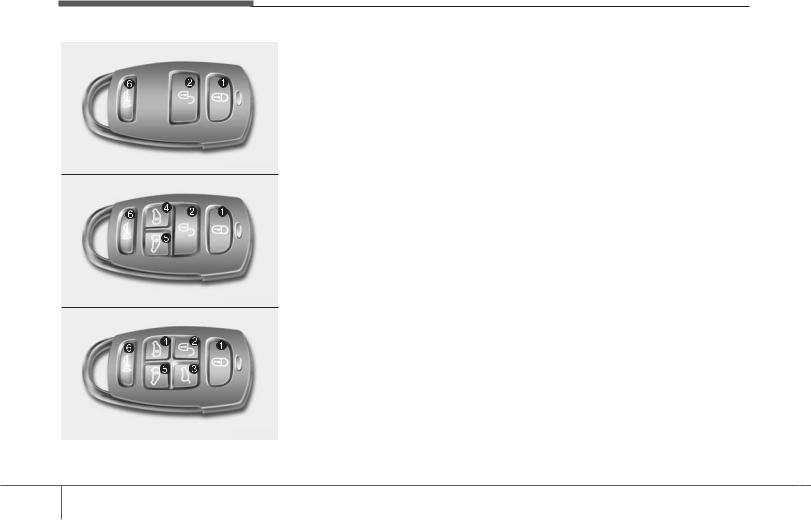
Features of your vehicle
REMOTE KEYLESS ENTRY (IF EQUIPPED)
Type A
1VQA2002B
Type B
1VQA2002A
Type C
(1)Lock (  )
)
All doors are locked if the lock button is pressed.
If all doors are closed, the hazard warning lights blink once to indicate that all doors are locked. However, if any door remains open, the hazard warning lights are not operated. After this, if all door are closed, the hazard warning lights blink.
(2)Unlock (  )
)
Driver's door is unlocked if the unlock button is pressed once.
The hazard warning lights will blink twice to indicate that the driver's door is unlocked.
All doors are unlocked if the unlock button is pressed twice within 3 seconds.
The hazard warning lights will blink twice again to indicate that all doors are unlocked.
After depressing this button, the doors will be locked automatically unless you open any door within 30 seconds.
1VQA2002
(3)Power tailgate opening or closing ( , if equipped)
, if equipped)
The tailgate is opened or closed automatically if the button is pressed. The hazard warning lights will blink and the chime will sound 3 times to indicate that the tailgate will swing upward or downward.
(4)Left power sliding door opening or closing (  , if equipped)
, if equipped)
The left sliding door is opened or closed automatically if the button is pressed.
(5)Right power sliding door opening or closing (  , if equipped)
, if equipped)
The right sliding door is opened or closed automatically if the button is pressed.
3 4

Features of your vehicle
NOTICE
The power sliding door and power tailgate are not opened by pressing the corresponding button on the transmitter directly when all power sliding doors and power tailgate are locked and closed. To open the power sliding door or power tailgate from outside vehicle, press the unlock button twice within 3 seconds first and press corresponding power sliding door or power tailgate opening button.
 CAUTION
CAUTION
The power doors can be operated when the engine is not running. However, the power doors consume large amounts of vehicle electric power. To prevent the battery from being discharged, do not operate them consecutively (more than approximately 10 times).
(6) Alarm ( 
 )
)
The horn sounds and hazard warning lights flash for about 27 seconds if this button is pressed. To stop the horn and lights, press any button on the transmitter.
NOTICE
The transmitter will not work if any of following occur:
•The ignition key is in ignition switch.
•You exceed the operating distance limit (about 90 feet [30 m]).
•The battery in the transmitter is weak.
•Other vehicles or objects may be blocking the signal.
•The weather is extremely cold.
•The transmitter is close to a radio transmitter such as a radio station or an airport which can interfere with normal operation of the transmitter.
When the transmitter does not work correctly, open and close the door with the ignition key. If you have a problem with the transmitter, contact an authorized Hyundai Dealer.
 CAUTION
CAUTION
Keep the transmitter away from water or any liquid. If the keyless entry system is inoperative due to exposure to water or liquids, it will not be covered by your manufacturer vehicle warranty.
Operational distance may vary depending upon the area the transmitter is used in. For example, if the vehicle is parked near police stations, government and public offices, broadcasting stations, military installations, airports, or transmitting towers, etc.
3 5

Features of your vehicle
This device complies with Part 15 of the FCC rules. Operation is subject to the following two conditions:
1.This device may not cause harmful interference, and
2.This device must accept any interference received, including interference that may cause undesired operation.
 CAUTION
CAUTION
Changes or modifications not expressly approved by the party responsible for compliance could void the user’s authority to operate the equipment.
1VQA2003
Battery replacement
Transmitter uses a 3 volt lithium battery which will normally last for several years. When replacement is necessary, use the following procedure.
1.Insert a slim tool into the slot and gently pry open the transmitter center cover (1).
2.Replace the battery with new one. When replacing the battery, make sure the battery positive “+” symbol faces up as indicated in the illustration.
3.Install the battery in the reverse order of removal.
For replacement transmitters, see an Authorized Hyundai Dealer for reprogramming.
 CAUTION
CAUTION
The keyless entry system transmitter is designed to give you years of trouble-free use, however it can malfunction if exposed to moisture or static electricity. If you are unsure how to use your transmitter or replace the battery, contact an authorized Hyundai dealer.
 CAUTION
CAUTION
•Using the wrong battery can cause the transmitter to malfunction. Be sure to use the correct battery.
•To avoid damaging the transmitter, don't drop it, get it wet, or expose it to heat or sunlight.
3 6

THEFT-ALARM SYSTEM (IF EQUIPPED)
Armed
stage
Disarmed |
|
|
|
Theft-alarm |
stage |
|
|
|
stage |
|
|
|
|
|
This system is designed to provide protection from unauthorized entry into the car. This system is operated in three stages: the first is the "Armed" stage, the second is the "Theft-alarm" stage, and the third is the "Disarmed" stage. If triggered, the system provides an audible alarm with blinking of the hazard warning lights.
Armed stage
Park the car and stop the engine. Arm the system as described below.
1.Remove the ignition key from the ignition switch.
2.Make sure that all doors, the engine hood and tailgate are closed and latched.
3.Lock the doors using the transmitter of the keyless entry system.
After completion of the steps above, the hazard warning lights will blink once to indicate that the system is armed.
If any door, tailgate or engine hood remains open, the hazard warning lights won’t operate and theft-alarm will not arm. After this, if all doors, tailgate and engine hood are closed, the hazard warning lights blink once.
The system can be armed by locking the doors with the key from the front doors or tailgate. However, the hazard warning lights are not operated.
Features of your vehicle
•If any door, tailgate or engine hood remains open, the system will not be armed. If this happens, re-arm the system as described previously.
•Do not arm the system until all passengers have left the vehicle. If the system is armed while a passenger(s) remains in the vehicle, the alarm may be activated when the remaining passenger(s) leaves the vehicle. If any door, tailgate or engine hood is opened within 30 seconds after entering the armed stage, the system is disarmed.
3 7

Features of your vehicle
Theft-alarm stage
The alarm will be activated if any of the following occurs while the system is armed.
•A front or rear door is opened without using the ignition key or transmitter.
•The tailgate is opened without using the ignition key or transmitter.
•The engine hood is opened.
The siren will sound and the hazard warning lights will blink continuously for 27 seconds, and repeat the alarm 3 times unless the system is disarmed. To turn off the system, unlock the doors with the ignition key or transmitter.
NOTICE
Avoid trying to start the engine while the alarm is activated. The vehicle starting motor is disabled during the theftalarm stage.
Disarmed stage
The system will be disarmed when the doors are unlocked by depressing the unlock button on the transmitter or unlocked with the ignition key.
After depressing unlock button, the hazard warning lights will blink twice to indicate that the system is disarmed.
After depressing unlock button, if any door is not opened within 30 seconds, the system will be rearmed.
If the system is not disarmed with the ignition key or transmitter, insert the key in the ignition switch, turn the key to the ON position and wait for 30 seconds. Then the system will be disarmed.
IMMOBILIZER SYSTEM (IF EQUIPPED)
Your vehicle is equipped with an electronic engine immobilizer system to reduce the risk of unauthorized vehicle use.
Your immobilizer system is comprised of a small transponder in the ignition key, and antenna coil in the key cylinder and Immobilizer Control Unit (or Smartra Unit).
With this system, whenever you insert your ignition key into the ignition switch and turn it to ON, the antenna coil in the ignition switch receives a signal from the transponder in the ignition key and then sends the signal to the ECU (Engine Control Unit).
The ECU checks the signal whether the ignition key is valid.
If the key is determined to be valid, the engine will start.
If the key is determined to be invalid, the engine will not start.
3 8

Features of your vehicle
To deactivate the immobilizer system:
Insert the ignition key into the key cylinder and turn it to the ON position.
To activate the immobilizer system:
Turn the ignition key to the OFF position. The immobilizer system activates automatically. Without a valid ignition key for your vehicle, the engine will not start.
 WARNING
WARNING
In order to prevent theft of your vehicle, do not leave spare keys anywhere in your vehicle. Your Immobilizer password is a customer unique password and should be kept confidential. Do not leave this number anywhere in your vehicle.
NOTICE
When starting the engine, do not use the key with other immobilizer keys in close proximity to your vehicle’s ignition switch, otherwise the engine may not start or may stop soon after it starts.
NOTICE
If you need additional keys or lose your keys, consult your authorized Hyundai dealer.
 CAUTION
CAUTION
Do not put metal accessories near the key or ignition key.
The engine may not start for the metal accessories may interrupt the transponder signal from normally transmitting
Limp home (override) procedure
When you turn the ignition key to the ON position, if the immobilizer indicator (  ) goes off after blinking 5 times, your transponder equipped in the ignition key is out of order. You cannot start the engine without the lime home procedure. To start the engine, you have to input your password by using the ignition switch.
) goes off after blinking 5 times, your transponder equipped in the ignition key is out of order. You cannot start the engine without the lime home procedure. To start the engine, you have to input your password by using the ignition switch.
The following procedure is how to input your password of “2345” as an example.
1.Turn the ignition key to the ON position. The immobilizer indicator (  ) will blink 5 times and go off indicating the beginning of the limp home procedure.
) will blink 5 times and go off indicating the beginning of the limp home procedure.
2.Turn the ignition key to the ACC position.
3.To enter the first digit (in this example “2”), turn the ignition key to the ON and ACC position twice. Perform the same procedure for the next digits between 3 seconds and 10 seconds (for example, for “3”, turn the ignition ON and ACC 3 times).
3 9

Features of your vehicle
4.If all of the digits have been input successfully, you have to start the engine within 30 seconds. If you attempt to start the engine after 30 seconds, the engine will not start and you will have to input your password again.
After performing the limp home procedure, you have to see an authorized Hyundai dealer immediately to inspect and repair your ignition key or immobilizer system.
 CAUTION
CAUTION
The transponder in your ignition key is an important part of the immobilizer system. It is designed to give years of trouble-free service, however you should avoid exposure to moisture, static electricity and rough handling.
 CAUTION
CAUTION
Do not change, alter or adjust the immobilizer system because it could cause the immobilizer system to malfunction. The system should only be serviced by an authorized Hyundai dealer.
Malfunctions caused by improper alterations, adjustments or modifications to the immobilizer system are not covered by your vehicle manufacturer warranty.
This device complies with Part 15 of the FCC rules. Operation is subject to the following two conditions:
1.This device may not cause harmful interference, and
2.This device must accept any interference received, including interference that may cause undesired operation.
 CAUTION
CAUTION
Changes or modifications not expressly approved by the party responsible for compliance could void the user's authority to operate the equipment.
DOOR LOCKS
Front doors
Unlock
Lock
1VQA2004
Operating door locks from outside the vehicle
•Turn the key toward rear of vehicle to unlock and toward front of vehicle to lock.
•Turn the key toward front of vehicle to lock all doors.
•From the driver’s door, turn the key to the right once to unlock the driver’s door and to the right twice within 3 seconds to unlock all doors.
•From the passenger’s door, turn the key to the left once to unlock the passenger’s door and to the left twice within 3 seconds to unlock all doors.
•Doors can also be locked and unlocked with the transmitter key (if equipped).
3 10

Features of your vehicle
•Once the doors are unlocked, they may be opened by pulling the door handle.
•To close the door, push the door by hand. Make sure that doors are closed securely.
 WARNING
WARNING
In cold and wet climates, door lock and door mechanisms may not work properly due to freezing conditions. Be sure that all the doors are securely closed before driving the vehicle.
 WARNING
WARNING
Doors should be kept locked and the keys should be kept out of the reach of children. Never let children play in or around an unattended vehicle. Even very young children may inadvertently cause the vehicle to move or entangle themselves in the windows. Parents must teach their children about the dangers of playing in unattended vehicles.
Rear sliding doors
1VQA2005
•Once the rear doors are unlocked, they may be opened by pulling the door handle and sliding the door towards the rear of the vehicle.
Rear sliding doors
 Pull
Pull
 Slide
Slide
OVQ047205
•When the rear door is fully open, the door will lock into an open position. To close the door, pull out the door handle
(1) and slide the door (2) towards the front of vehicle.
•If the window on the rear sliding door is open (more than 3 in./80 mm), the rear sliding door will not open fully, but will open to the 3/4 position.
3 11
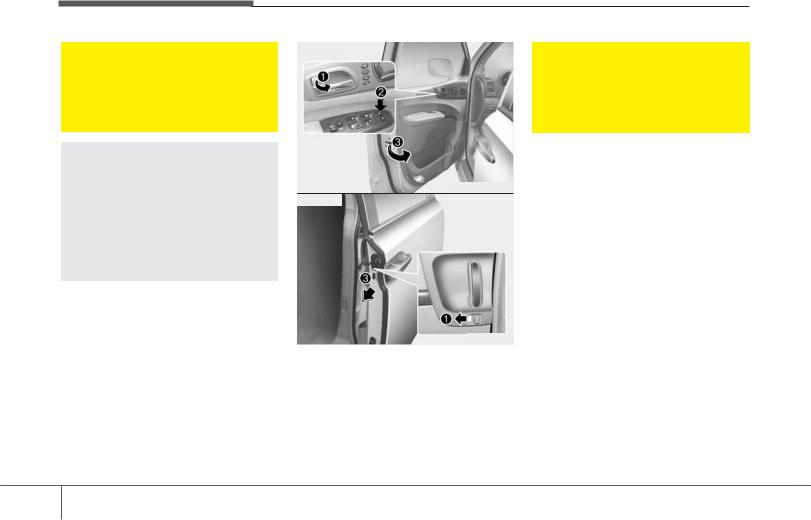
Features of your vehicle
 WARNING
WARNING
When the rear sliding door is not fully open, it is not latched and may move unintentionally. This could result in a serious injury.
 CAUTION
CAUTION
The left sliding door cannot be opened when the fuel filler lid is open. However, if the fuel filler lid is opened after the door is opened slightly, the left sliding door can be slide rearward. Close the left sliding door to prevent possible damage to the door or the fuel filler lid.
Front door
OVQ036001N
Rear door
1VQA2327
To lock a door without the key, push the inside door lock button (1) or door lock switch (2) to the “Lock” position and close the door (3).
 WARNING
WARNING
Always remove the ignition key, engage the parking brake, close all windows and lock all doors when leaving your vehicle unattended.
NOTICE
If the door is locked/unlocked multiple times in rapid succession with either the vehicle key or door lock switch, the system may stop operating temporarily in order to protect the circuit and prevent damage to system components.
3 12
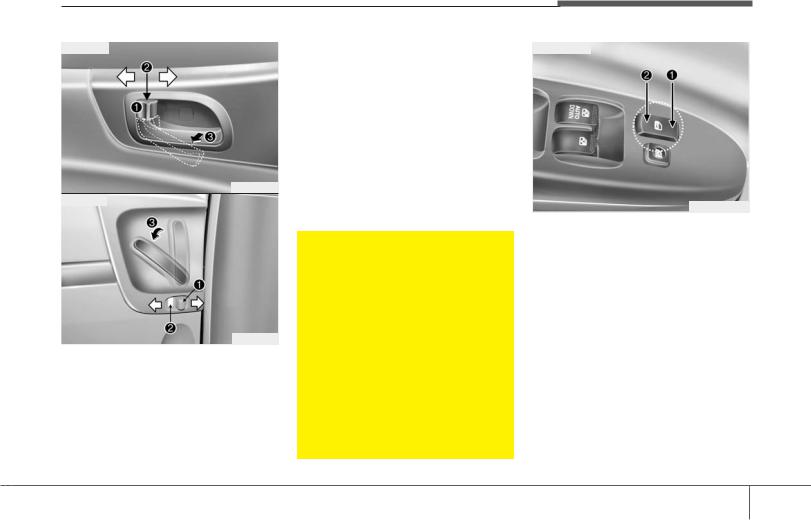
Features of your vehicle
Front door
Unlock |
|
Lock |
1VQA2007
Rear door
Lock |
|
Unlock |
1VQA2008
Operating door locks from inside the vehicle
With the door lock button
•To unlock a door, pull the door lock button (1) to the “Unlock” position. If the door is unlocked, the red part (2) of the button becomes visible.
•To lock a door, push the door lock button (1) to the “Lock” position. If the door is locked, red part (2) of the button is not visible.
•To open a door, pull the door handle
(3).
•If the inner door handle of the front door is pulled when the door lock button is in lock position, the button is unlocked and door opens. (if equipped)
•Front doors cannot be locked if the ignition key is in the ignition switch and door is open.
 WARNING - Door lock malfunction
WARNING - Door lock malfunction
If a power door lock ever fails to function while you are in the vehicle, try one or more of the following techniques to exit:
•Operate the door unlock feature repeatedly (both electronic and manual) while simultaneously pulling on the door handle.
•Operate the other door locks and handles, front and rear.
•Lower a front window and use the key to unlock the door from outside.
Driver’s door
OVQ026021N
With central door lock switch
The central door locking switch is located on the front door arm rest. It is operated by depressing the door lock switch. If any door is open when the switch is depressed (1), the door will remain locked when closed.
3 13
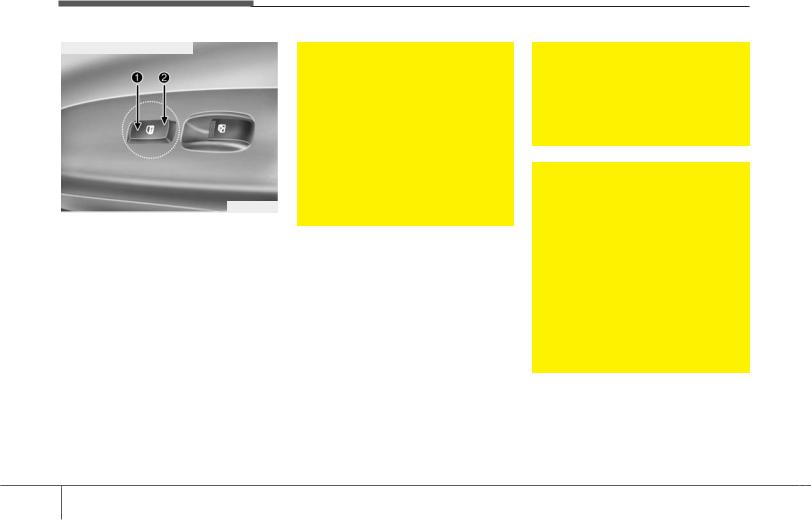
Features of your vehicle
Passenger’s door (if equipped)
1VQA2012
•When pushing down on the front portion (1) of the switch, all vehicle doors will lock.
•When pushing down on the rear portion (2) of the switch, all vehicle doors will unlock.
•However, if the key is in the ignition switch and any front door is open, the doors will not lock when the front portion of central door lock switch is pressed.
 WARNING - Doors
WARNING - Doors
•The doors should always be fully closed and locked while the vehicle is in motion to prevent accidental opening of the door.
•Be careful when opening doors and watch for vehicles, motorcycles, bicycles or pedestrians approaching the vehicle in the path of the door. Opening a door when something is approaching can cause damage or injury.
 WARNING - Unlocked vehicles
WARNING - Unlocked vehicles
Always remove the ignition key, engage the parking brake, close all windows and lock all doors when leaving your vehicle unattended.
 WARNING - Unattended
WARNING - Unattended
children
•NEVER leave any child or animal unattended in the vehicle. Even very young children may inadvertently cause the vehicle to move, entangle themselves in the windows, or otherwise injure themselves or others.
•An enclosed vehicle can become extremely hot, causing death or severe injury to unattended children or animals who cannot escape the vehicle.
3 14
